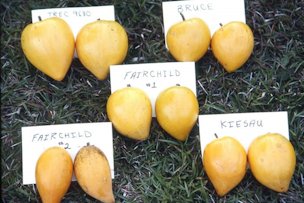Canistel Varieties There are a number of canistel varieties available in Florida. Most are of good quality, but fruit vary in size and shape. 1
 Canistel cultivars  ‘Bruce’ is a large, uniform and attractive fruit shaped much like a Hersey’s chocolate kiss (only yellow). Fruiting occurs in two major waves during August to October and again from February to March. There are 2 to 3 seeds in each fruit and plenty to eat. Fruits have dry flesh, are large and are of fair eating quality. 2 ‘Fairchild’ is a compact tree with slightly curved more elongated fruit. The production is heavy and its timing is roughly the same as with the previous variety. 2 ‘Ross’ is distintive among the others selections. The fruit are flattened like a hole-less doughnut and often is slightly flutted. The flesh is juicy and there are from 3 to 5 seeds in the fruit. The tree is slow growing and easy to control. 2 'Trompo' (formerly 9681) is a University of Florida selection. The fruit is large, sweet and has excellent texture. 2 Further Reading Evaluation of 'Oro' and Trompo' Canistel {Pouteria campechiana Baehni) at the University of Florida Tropical Research and Education Center, Homestead, Proc. Fla. State Hort. Soc. pdf Canistel Cultivars in South Florida, Proc. Fla. State Hort. Soc. pdf Back to Canistel Page |
|||||||||||||||||||||||||||||||||||||||||||||||||||||||||||||||||||||||||||||
| Bibliography 1 Crane, Johathan H., and Carlos F. Balerdi. "Canistel Growing in the Florida Home Landscape." Horticultural Sciences Dept., UF/IFAS Extension, HS1049, Original pub. Nov. 2005, Revised Oct. 2006, and Nov. 2016, Reviewed Dec. 2019, AskIFAS, edis.ifas.ufl.edu/hs299. Accessed 4 Apr. 2017, 2 July 2020. 2 Ledesma, Noris. "The Canistel, A Winter Fruit for South Florida." Fairchild Tropical Botanic Garden, 20 Apr. 2012, fairchildgarden.org. Accessed 24 Dec. 2014. Published 16 Jan. 2015 LR. Last update 26 Oct. 2020 LR |
|||||||||||||||||||||||||||||||||||||||||||||||||||||||||||||||||||||||||||||